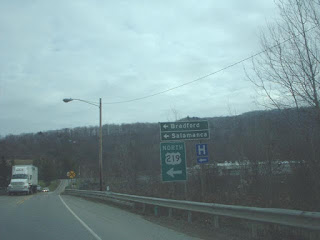The US 219 Bypass around Bradford, Pennsylvania was akin to taking a trip back into the 1970s. Vintage PennDOT highway design, faded pre-1980 guide signage (and the signs have exit tabs without exit numbers) and concrete are abundant on this stretch of US 219. Bradford also has its roots as being an industrial city, and seems to have shown the usual decline of industry in the Northern United States. However, Zippo (the lighter fuel company) is still headquartered in Bradford. Here are photos I have taken of the Bradford Bypass as it looked like on December 12, 2001. The signs have since been replaced.
 |
| US 219 southbound at the PA 46 Kendall Avenue exit. |
 |
| US 219 southbound at the PA 346 Foster Brook exit. |
 |
| US 219 northbound at the PA 346 Elm Street exit. |
 |
| US 219 northbound at the PA 46 Kendall Avenue exit. |
 |
| US 219 northbound at the PA 346 Foster Brook exit. |
 |
| US 219 northbound at Owens Way. The freeway used to end here as a stub, but now continues just past Owens Way. |
 |
| US 219 southbound at Owens Way. The freeway used to end here as a stub. |
 |
| US 219 southbound approaching the PA 346 Foster Brook exit. |

Comments